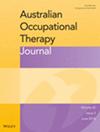Patient experiences of occupational formulation: It's about getting to know me
Abstract
Introduction
Occupational formulation is a synthesis of assessment information that describes a person's occupational participation and needs, to guide collaborative goal and therapy planning. This study aimed to explore patients' experiences of creating occupational formulations and reflecting on them in an Australian secure forensic hospital.
Method
This qualitative descriptive study is part of a larger participatory action research project aiming to implement occupational formulation and evaluate its use within a forensic occupational therapy service. An occupational therapist researcher and lived experience worker co-interviewed patients who had completed an occupational formulation. A semi-structured interview guide and chart stimulated recall were used to support discussion with each participant about their occupational formulation. The audio-recorded interviews were transcribed, and reflexive thematic analysis was conducted.
Consumer and community involvement
Extensive consultation with members of the lived experience, occupational therapy and social work teams, and the hospital's consumer advisory group informed the design and implementation of this study.
Findings
Ten forensic patients, including nine male and one female (aged 30s–60s) from four units, participated in interviews. Three themes were developed. The first, “a getting-to-know-you piece,” describes how participants viewed the occupational formulation and the process of developing it. The second, “talking about losses and limitations” reflects the challenges within the forensic system that participants highlighted through creating and reading their occupational formulations, while the third, “valuing its potential” depicts how the occupational formulations were used and could potentially be used.
Conclusion
Overall, participants viewed occupational formulation positively and valued being heard and understood. The approach benefited patients and the therapeutic relationship, supporting collaboration and potentially shifting power within the patient-therapist relationship. The study also identified missed opportunities to support further reflection and collaborative progress review. Suggestions were made for strengthening the development, documentation, and review of occupational formulations and goals.
PLAIN LANGUAGE SUMMARY
Occupational therapists try to learn about people's daily lives to understand what matters to each person and set therapy goals together. One way they do this is through a process called an occupational formulation. This is a written summary made with the person to show what they need and want in their life. This study looked at how patients felt about using occupational formulation in a secure forensic hospital. This is a new way of working, so we wanted to learn more about how it was used and what patients thought about it.
The study was planned with help from people with lived experience, occupational therapists, social workers, and the hospital's Consumer Advisory Group. An occupational therapist and a lived experience worker interviewed 10 patients about their occupational formulations. The interviews were recorded and written down. Researchers then looked at what the patients said to find common ideas.
Three themes were identified: getting to know the person, talking about losses and limitations, and how the formulation helped or could be helpful. Most patients said the process was helpful. It made it easier to work with their occupational therapist and talk about what was important to them. They also wanted more chances to check in on their goals.
Based on what we learned, we made suggestions to help therapists improve how they create and review occupational formulations with patients. More research could look at how this works in other places.

 求助内容:
求助内容: 应助结果提醒方式:
应助结果提醒方式:


